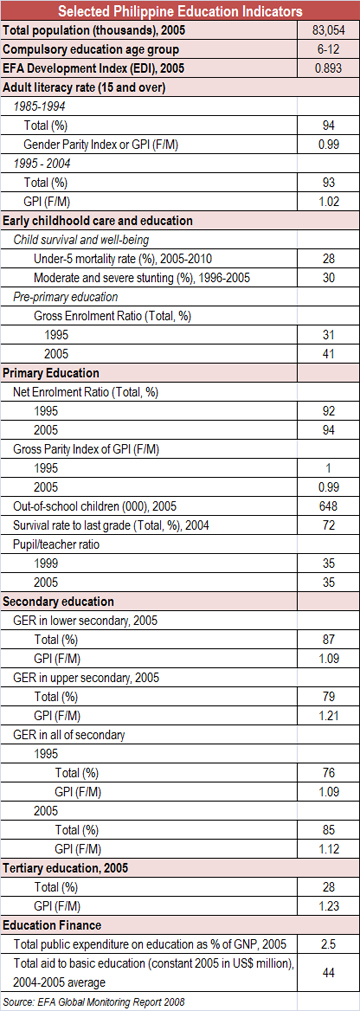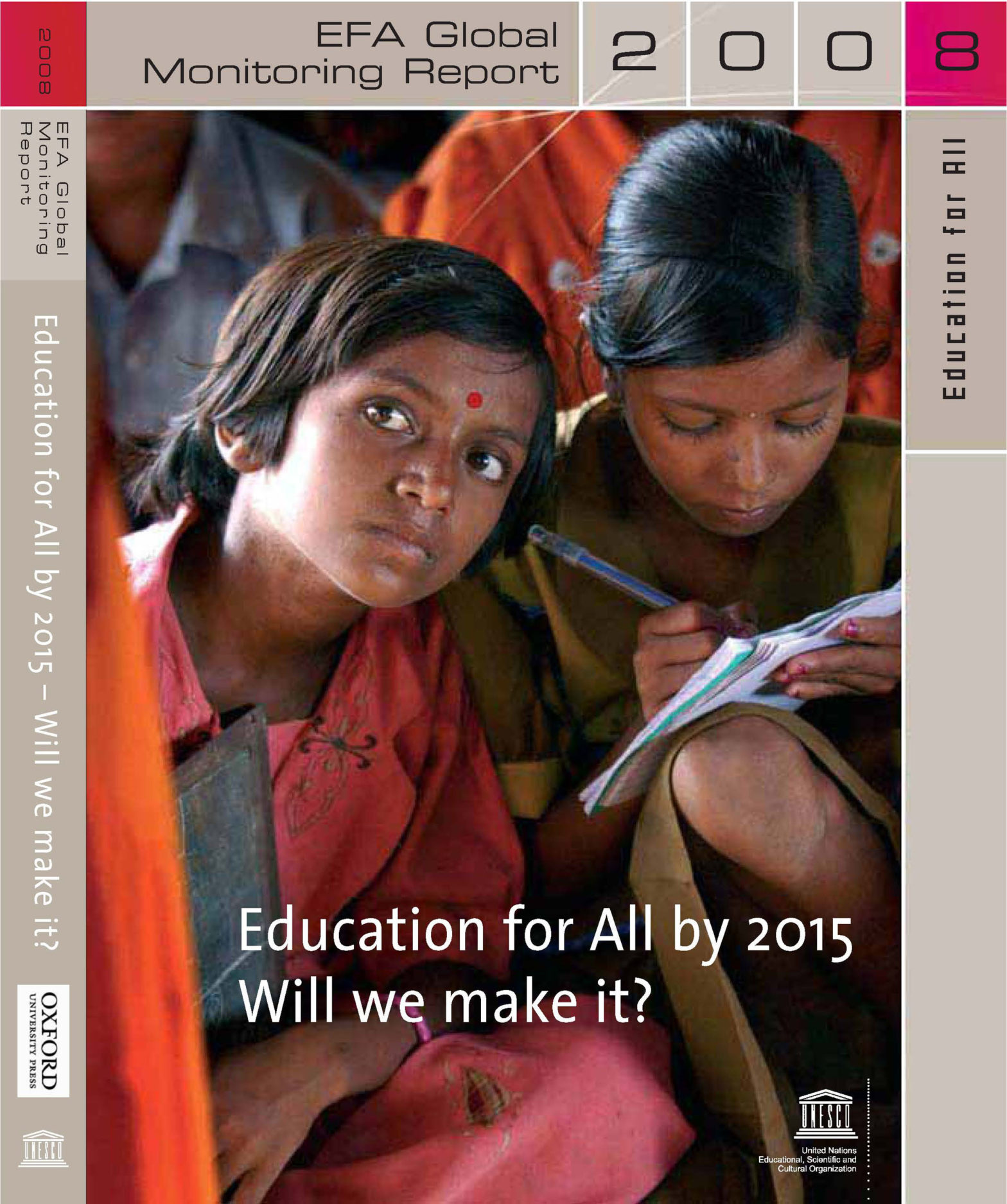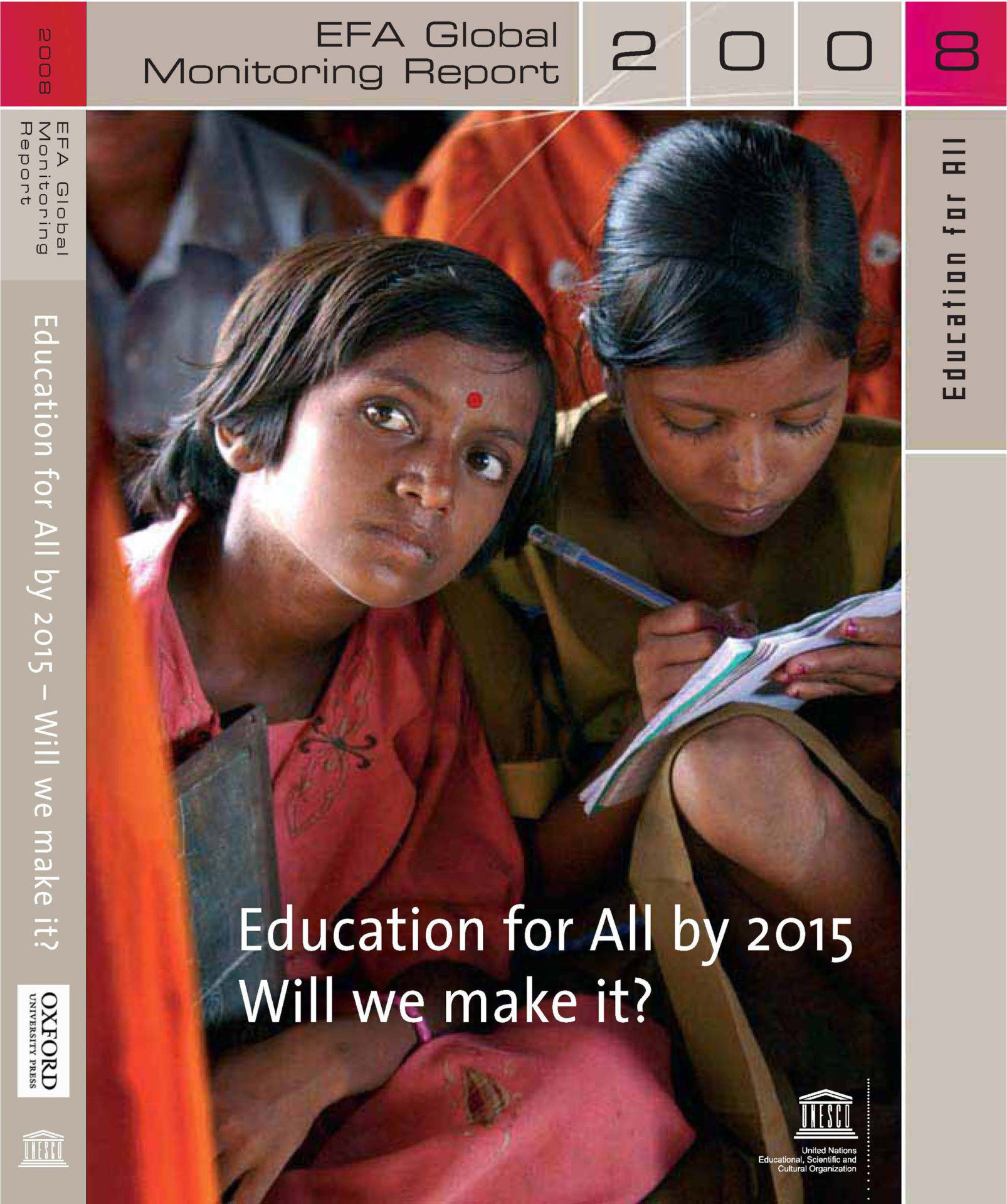By YVONNE T. CHUA
WITH seven years to go, the Philippines is in danger of not meeting all the targets that have been set for countries to provide “Education for All” by 2015.
“Education for All by 2015 – Will we make it?”, a midterm review of progress across the six EFA goals released recently by the United Nations Educational, Scientific and Cultural Organization or UNESCO, said the country is “at risk” of not achieving the goals on adult literacy and gender parity.
Adult literacy in the Philippines stood at 93 percent in 2004. But the number of adult illiterates stood at 3.78 million in 2004 and is projected to rise to 4 million by 2015. Forty-six percent are females who can’t read, write or count.
In the case of gender disparity, the UNESCO report noted that school-age boys in the Philippines are under-enrolled in both elementary and high schools. Many more women are also enrolled in colleges and universities.
Gender disparities are “at the expense of boys,” said the report.
 Prospects of achieving universal primary education, however, appear high for the Philippines. It is one of two countries in the East Asian region expected to have all children in grade school by 2015. The other is Myanmar.
Prospects of achieving universal primary education, however, appear high for the Philippines. It is one of two countries in the East Asian region expected to have all children in grade school by 2015. The other is Myanmar.
Adopted in 2000 in Dakar, Senegal, the six internationally agreed education goals that countries pledged to meet by 2015 include: expanded early childhood care and education; free and compulsory primary education for all; learning and life skills for young people and adults; increase in adult literacy by 50 percent; gender parity by 2005 and gender equality by 2015; and improved quality of education.
With an EFA Development Index (EDI) of 0.893, the Philippines falls in an “intermediate” position or more than halfway close to meeting EFA goals.
While the country’s primary enrolment is high, its EDI has been pulled down by the poor survival rate to Grade 5, according to UNESCO. Only three of every four Filipino pupils make it to Grade 5.
UNESCO listed the Philippines among the East Asian countries that “face the greatest challenge” in the number of out-of-school children.
In East Asia, only South Korea is at present EFA-compliant and only one other country—Brunei—almost making the grade.
Introduced in 2003, the EDI is a composite measure of a country’s situation as far as achieving the EFA goals. At present, it focuses on four goals: universal primary education, adult literacy, gender parity and equality, and education quality.
The midterm EFA report said the Philippines counts among the countries with relatively low enrolment ratios, or about 40 percent or less, in preschool education.
It also found what it called a “strong negative correlation” between household poverty and the primary school attendance rate in both rural and urban areas in the Philippines. This means the poor are not likely to go to elementary school.
At 35:1, the pupil-to-teacher ratio in the Philippines is still considered high compared to the global average (25:1) and the average for developing countries (28:1).
The Philippines figures among the two dozen countries that devote less than 3 percent of its gross national product to public spending on education. It has had to rely substantially on aid to finance basic education, UNESCO noted.
Like households in Indonesia, Japan, South Korea and Thailand, Filipino families channel more than 22 percent of their expenses to education. The expenses include tuition and other fees, schools supplies and uniforms and contributions to parents associations.
The UNESCO report cited several education initiatives in the Philippines, including the provision of food for poor children in preschool and Grade 1 and the equivalency or “second chance,” nonformal education, Adopt-a-School, Brigada Eskwela, and Classroom Galing sa Mamamayang Pilipino Abroad (Classrooms from Overseas Filipino Workers) programs.
DEFINITION OF TERMS
Adult literacy rate: Number of literate persons aged 15 and above, expressed as a percentage of the total population in that age group.
Child- or under-5 mortality rate: Probability of dying between birth and the fifth birthday. It is expressed as deaths per 1,000 live births.
Compulsory education or attendance: Educational programmes that children and young people are legally obliged to attend, usually defined in terms of a number of grades or an age range, or both.
Early Childhood Care and Education (ECCE): Programs that, in addition to providing children with care, offer a structured and purposeful set of learning activities either in a formal institution (pre-primary or International Standard Classification of Education 0) or as part of a nonformal child development program. ECCE programs are normally designed for children from age 3 and include organized learning activities that constitute, on average, the equivalent of at least two hours per day and 100 days per year.
Gross Enrolment Ratio (GER): Total enrolment in a specific level of education, regardless of age, expressed as a percentage of the population in the official age group corresponding to this level of education. For the tertiary level, the population used is that of the five-year age group following on from the secondary school leaving age. The GER can exceed 100 percent due to late entry or/and repetition.
Gross National Product (GNP): Gross domestic product plus net receipts of income from abroad. As these receipts may be positive or negative, GNP may be greater or smaller than GDP. This latter indicator is the sum of gross value added by all resident producers in the economy, including distributive trades and transport, plus any product taxes and minus any subsidies not included in the value of the products.
Gender Parity Index (GPI): Ratio of female to male values (or male to female, in certain cases) of a given indicator. A GPI of 1 indicates parity between sexes; a GPI above or below 1 indicates a disparity in favour of one sex over the other.
Net Enrolment Ratio (NER): Enrolment of the official age group for a given level of education, expressed as a percentage of the population in that age group.

